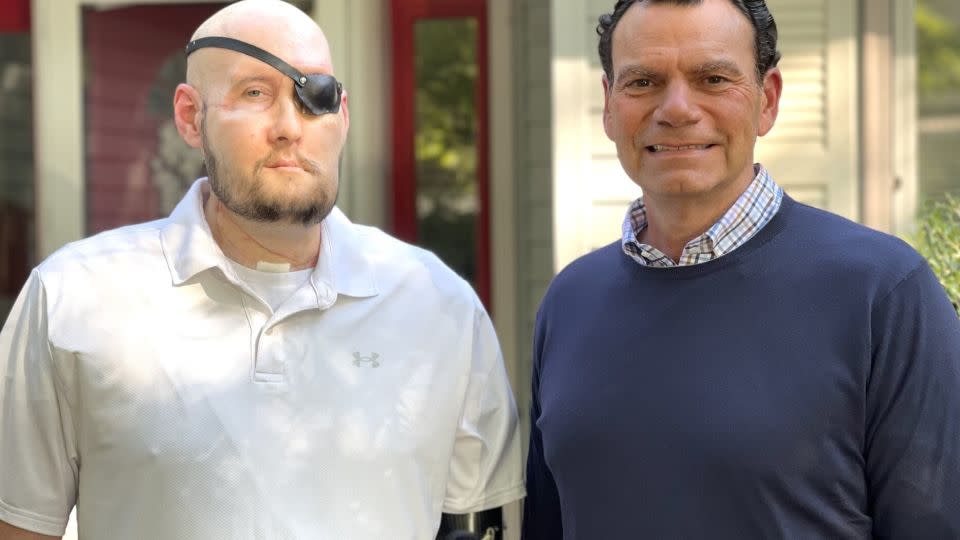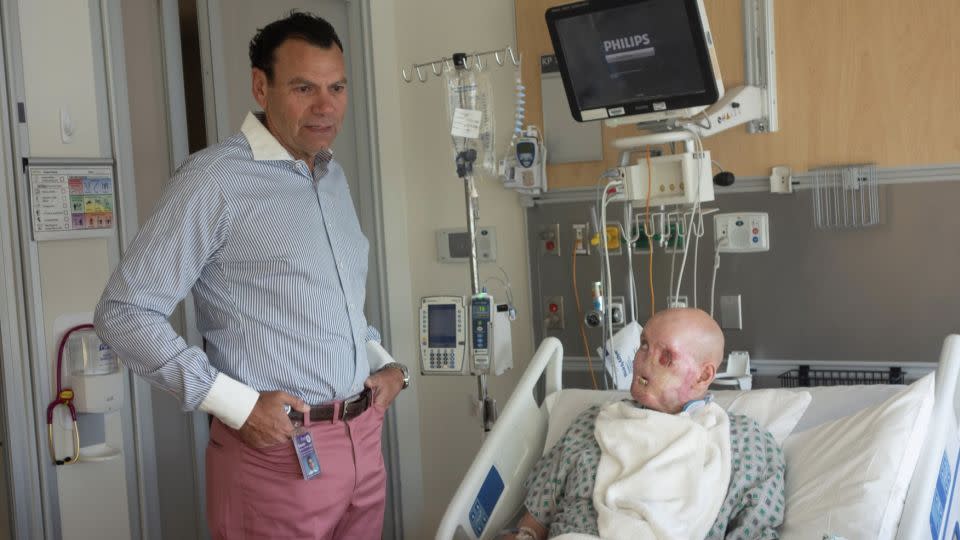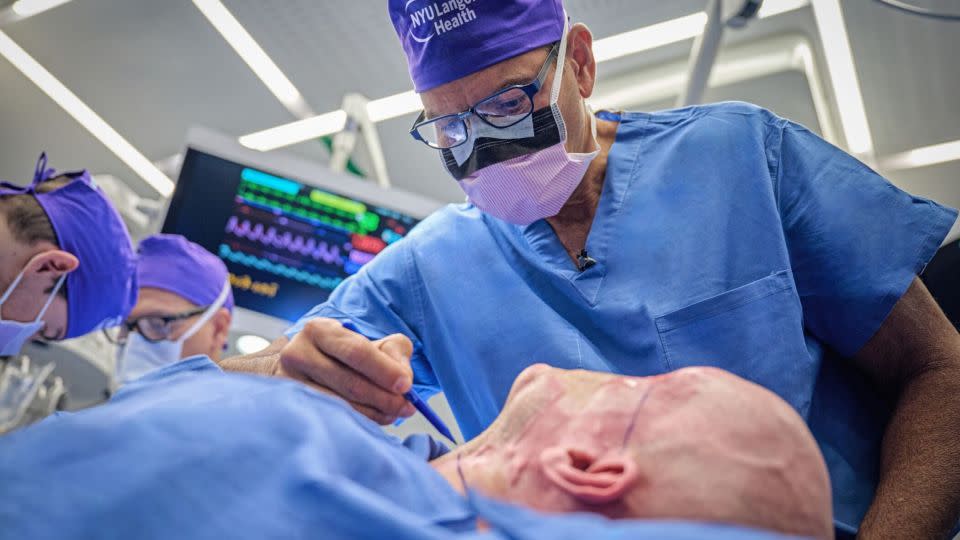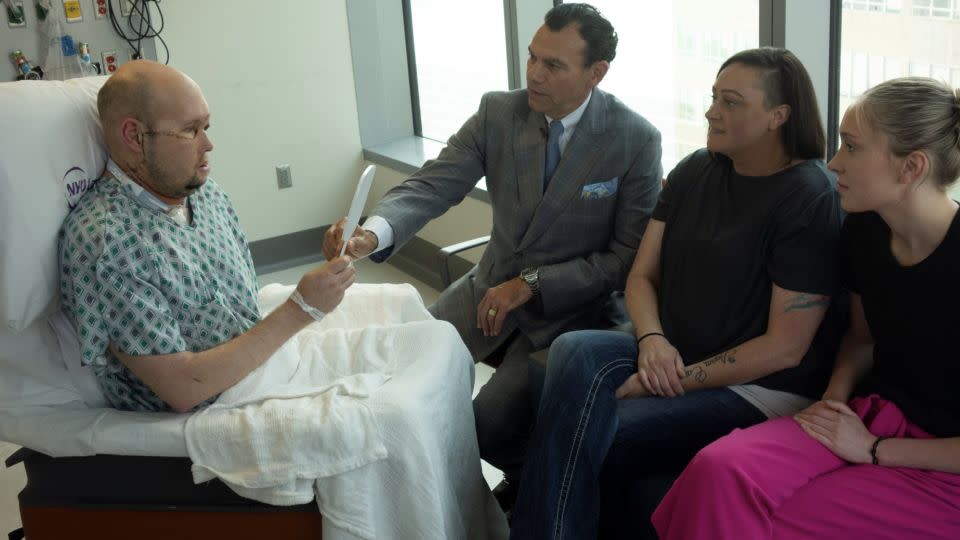World’s first whole-eye and partial face transplant gives Arkansas man new hope
unknown content item
-
It was a moment Meagan James never expected to witness.
A surgical team at NYU Langone Health in New York had performed the world’s first successful whole-eye transplant in a living person: her husband, Aaron James.
After an accident at work led to the loss of his left eye and part of his face, Aaron was given a new window to his soul, as well as a partial face transplant.
When Meagan peered into her husband’s new eye for the first time, she noticed the post-surgery swelling and saw that the eye was brown. Aaron naturally has ocean-blue eyes.
She also saw his new nose, lips and cheek, which already had some beard stubble growing. She saw a face filled with gratitude, and that’s when the emotion set in.
She was happy for her husband of 20 years.
“It was a crazy, great, weird, strange, ecstatic, happy feeling,” Meagan said. “I was just happy he made it through, and everything was good in the moment.”
On that day in late May, a team of more than 140 surgeons at NYU Langone Health completed Aaron’s transplantation procedure, which lasted about 21 hours. The surgery included transplanting the entire left eye and parts of the face from a single donor. It was a medical first.

Aaron’s eye is now showing “remarkable” signs of health, according to his medical team. Although he can’t see out of the eye, he remains hopeful that vision might come with time — and that his first-of-its-kind procedure may help advance transplant medicine.
“That’s really my biggest hope,” Aaron said. “If I can see out of it, that’s great. But if it’ll kick-start the next path in the medical field, then I’m all for it.”
A life-changing accident
Seeing Aaron’s new eye and face “wasn’t as big of a shock” as seeing him the night of his accident, Meagan said.
Aaron, a 46-year-old military veteran based in Arkansas, worked as a high-voltage power lineman, and that night in June 2021, he was working with his colleagues in Mississippi when his face accidentally touched a live wire.
The deadly 7,200-volt electric shock caused extensive injuries to Aaron’s face: his left eye, his entire nose and lips, his left cheek area and chin, as well as his left arm.
Back in Arkansas, Meagan and their daughter, Allie, who was in high school, were driving home from the grocery store when Meagan’s phone rang. She didn’t recognize the number, but she still answered. She heard the words “Aaron,” “accident” and “serious.”
Meagan immediately packed a bag when she got home and then drove about four and a half hours to Mississippi, where Aaron was being cared for at a local hospital. During the drive, her phone rang again. This time, it was a doctor. The doctor described Aaron’s condition and explained that he had been electrocuted.
“Is he OK? Is he going to be OK?” Meagan asked. She recalls the doctor responding, “The only thing that I can promise you is that he won’t die before you get here.”
Meagan remembers that she would tell Aaron to “be careful” every morning before work. She still thinks back to the morning of his accident and wonders whether she told him to “be careful” that day.
‘Oh, my goodness, his face is gone’
Meagan remained by Aaron’s side as he was transported to different medical centers for more intensive care, for reconstructive surgeries and to have his left arm amputated.
After he was flown to a burn unit in Dallas, Allie, who was staying with her grandmother at the time, was able to visit him.
“When I saw him, his chinbone was exposed,” Allie said.
“I could see his eye socket and everything. I was seeing his skull, and I think that’s the part that was kind of freaky for me. I was like ‘Oh, my goodness, his face is gone,’” she said. “Most of my worries was just how he was going to be when he was awake and aware.”
Aaron said he doesn’t remember the accident at all.
“Basically, I got up, went to work and woke up six weeks later in Dallas, Texas,” he said. “It’s a weird feeling when you just all of a sudden wake up in a hospital.”
The first time Aaron saw himself after the accident was from his hospital bed in Dallas. He asked Meagan to take a photo, but she hesitated.
“She said, ‘Are you sure?’ I said, ‘Yeah, it’ll be fine,’” Aaron said.
“She took a picture, and she spun the phone around, and I was just like, ‘Oh, my goodness, this is a bad deal right here,’” he recalled. “I mean, I felt OK, so I knew I was going to be OK. We were just going to have a long road ahead of us.”
Aaron’s medical care team had mentioned the option of a face transplant to Meagan. When she then brought it up to Aaron, he said he was “all for it.”
“As soon as the face transplant got talked about, that’s when I thought, ‘Man, this is a big deal,’ because they just don’t do those every day,” he said.

In New York, Dr. Eduardo Rodriguez, director of the Face Transplant Program at NYU Langone Health — who had performed four face transplants before — and his colleagues were introduced to Aaron’s case by specialists in Texas.
After learning more about Aaron’s accident and subsequent injuries, Rodriguez said that it was “remarkable” that Aaron had survived.
“To see him walking when he was completely down for the count in the hospital — multiorgan system failure, breathing tube, is he going to make it, is he going to have neurological injury — to see him without any of those sequelae, it’s very impressive,” Rodriguez said.
“It’s a testament to modern medicine,” he said. “It’s a testament to this patient and his family. And it’s also a testament that, in these cases, there’s some celestial involvement where it wasn’t his time to go.”
‘You have to have a patient zero’
Discussions around the possibility of a transplant continued even after Aaron’s medical team in Texas had removed his left eye due to severe pain. Rodriguez and his colleagues in New York asked the Texas team to preserve as much of the optic nerve as possible in hopes of a potential eye transplant.
As Rodriguez talked with Aaron about the possibility of doing not just a partial face transplant but a whole-eye transplant, he warned that the donor eye might not restore vision. For there to be sight, there will have to be some communication between the transplanted eye and the brain.
“But I said ‘even if it don’t work, I’ll have an eye, and it will be at least normal-looking, and then you all could learn something off of this,’ ” Aaron said. “You have to have a patient zero.”
Aaron was listed as a potential recipient in February 2023. The opportunity to perform the whole-eye and partial facial transplant came just a few months later, in May.
It was a “risky” operation for Rodriguez and his colleagues. No medical team in the world had previously performed a successful human eye transplant in a living patient.
“It’s completely uncharted territory,” Rodriguez said.

The surgery involved two operating rooms. Aaron was in one room, where surgeons removed the parts of his face that would be replaced with donor tissue. Rodriguez was in the other room, dissecting the donor face and eyeball.
“That part of the operation took about 12 hours,” Rodriguez said.
“Now I have to ensure that Aaron’s room is ready to receive the face,” he said. “We cut the blood vessels, we disconnect it from the donor, and the race begins. At this point, the face and the eye are not receiving any blood supply.”
Rodriguez and his colleagues then began connecting the donor face and eyeball to Aaron. For the eye transplant, the team combined the donor eye with adult stem cells derived from the donor’s bone marrow by injecting the adult stem cells into the optic nerve during the transplant. Those stem cells may help enhance nerve regeneration.
“We were able to define a specific cell, a CD34, which is an adult stem cell that has some potential benefits — not only in immune modulation, because it is a transplant — but also neuro regeneration,” Rodriguez said. “At the connection of the optic nerve from the donor to the recipient, right at that site, we injected those CD34 stem cells.”
A key step in the whole-eye transplant surgery was reconnecting Aaron’s optic nerve to the donor eye, said Dr. José-Alain Sahel, clinical spokesperson for the American Academy of Ophthalmology. He was not involved in the procedure but is chair of the Department of Ophthalmology at the University of Pittsburgh School of Medicine and has been involved in related experimental research.
“It was very smart that they didn’t cut the optic nerve too far from the eyeball when the eye was removed in the recipient,” said Sahel, who has been following the NYU Langone Health team’s work.
“I think what remains to be done — which is a major, major undertaking — will be how to regrow the optic nerve, guide its fibers or axons to the appropriate targets, as well as making sure that the corneal nerves are well-preserved,” he said. “What we learn from this is that potentially the surgery can work, and then we should promote more research, more investment into research on corneal and optic nerve regeneration.”

When the surgery was complete and Aaron looked at his new face in a mirror for the first time, he was thrilled, Rodriguez said. Aaron continues to be closely monitored and must continue taking medications to reduce the risk of his body rejecting the transplant. His medical team notes that the eye has shown signs of health, such as having direct blood flow to the retina, the layer of tissue at the back of the eyeball associated with visual processing.
Looking ahead, Aaron, Meagan and their daughter, Allie, who recently graduated from high school, are preparing to celebrate Thanksgiving together in a couple of weeks. Aaron can now smell and taste — and looks forward to the Turkey Day meal. He also remains hopeful that on one miraculous day, he may be able to see out of his donor eye.
“As far as whether he will see or not, that’s the question that remains unanswered,” Rodriguez said.
“A transplant of this kind has never been done, and transplants have a unique way to work, and even in face transplants, things have occurred that we would not have imagined,” he said. “So, I’m hopeful.”
The procedure marks a major step for the field of transplant medicine, Dr. Oren Tepper, plastic and reconstructive surgeon and director of the Craniofacial Surgery Program at Montefiore Health System, said in an email.
“This highly technical and complex surgery represents a significant advancement in the field of face transplantation,” wrote Tepper, who was not involved in Aaron’s care.
“Ultimately, if transplanting an eye proves to be successful at restoring any form of nerve function or visual signals, this would be a tremendous breakthrough in medicine for patients who have suffered loss of the eye due to trauma or cancer.”
For more CNN news and newsletters create an account at CNN.com

 Yahoo News
Yahoo News 
